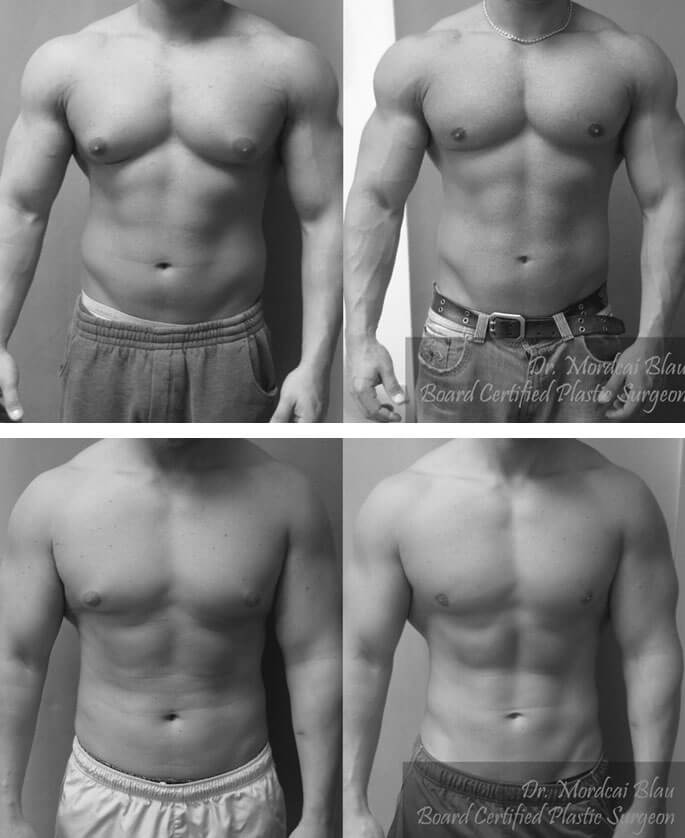Male Liposuction
Plastic Surgery Products
July 2006
Male Liposuction
by Mordcai Blau, MD, PC, with Gabriel Sheffer
Men have this procedure in different places from women—and often for different reasons
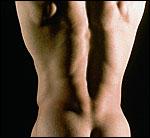 In 2005 alone, according to statistics from the American Society of Plastic Surgeons, 1.2 million aesthetic procedures were performed on men in the United States.1 That dramatic figure represents a 44% increase from 2000. Today, more than ever, male patients are open to the idea of aesthetic plastic surgery to eliminate a bump in their nose or to remove some fat from their waist.
In 2005 alone, according to statistics from the American Society of Plastic Surgeons, 1.2 million aesthetic procedures were performed on men in the United States.1 That dramatic figure represents a 44% increase from 2000. Today, more than ever, male patients are open to the idea of aesthetic plastic surgery to eliminate a bump in their nose or to remove some fat from their waist.
Interestingly, most men that visit an aesthetic surgeon are under the age of 45. Younger men are more inclined to see a plastic surgeon than older men—even for gynecomastia, a condition that presents more frequently in older men. Because most of today’s male patients are young, their numbers will only increase due to the combination of repeat business and future new patients.
Liposuction was the third most popular surgical procedure for men in 2005.1 As plastic surgeons continue to see an increasing number of male patients who request liposuction, it is important to recognize some fundamental differences in treating this population compared to females, who still represent almost 90% of patients who have this procedure.
Men, unlike women, do not typically present with fat in the thighs or the upper back. The most common areas addressed by liposuction in men are the waist, abdomen, lower back, breast, and neck. While not impossible, it is unlikely that a male patient would require liposuction in the upper back, arms, or legs, which are all common fat-collecting regions in females.
Another key difference between men and women concerns the makeup of the fatty tissue itself. Adipose tissue in women is softer and less fibrous than that found in men. Consequently, liposuction in men presents greater physical demands on the performing surgeon. Nevertheless, liposuction produces successful results in men, particularly in the waist.
Dealing With the Male Patient
As with female patients, males come with their unique set of pros and cons. With men, the advantages are seen early on, whereas the downside of treating this population emerges more frequently in the postoperative stage.
Men can be better candidates for liposcution than women, because, in my experience, men tend to take fewer medications. The male patients I see are less likely to take aspirin or suffer from migraines. Obviously, liposuction cannot be effective if a patient takes blood thinners, a major contributor to bleeding. So, I find that men are more reliable with respect to surgical precautions.
Other wise, before performing liposuction for male or female patients, a blood workup is needed to assess the patient’s likelihood of bleeding. This includes testing platelet count and checking prothrombin and partial prothrombin.
Postoperatively, it is difficult to manage male patients’ impetuosity. As we know, optimal recovery requires considerable rest, and males are less likely than females to be inactive. Staying sedentary is especially important in gynecomastia cases that incorporate a combination of liposuction and tissue excision.
In these cases, it is crucial that the patient comply with the standard regimen of bed rest and light movement for about 1 week, avoiding even a trip to the mall. I have seen men who disregard this postoperative advice develop hematomas and seromas, which often need to be drained.
Whereas I generally perform liposuction on overweight men under age 45, there are male patients who simply have a history of fatty breasts, waists, abdomens, or necks in their families. Many of these patients exercise and have been able to lose weight in other parts of their bodies. Still, they cannot rid themselves of fat in their body’s unique “Achilles’ heel.”
In addition, I see a considerable number of overweight patients who do not exercise. In these cases, liposuction can motivate the patient into maintaining a healthier diet and perhaps even beginning an exercise regimen.
I have found that abdominoplasty is much less frequent with my male liposuction patients than with their female counterparts. For every 20 or 30 female abdominoplasties I perform, I do only one on a male patient—in these cases, the patient is very obese.
The Procedure
Liposuction is performed in the same manner in male patients as it is in females. There are a few approaches, but we mostly use a tumescent method, in which a saline solution of lidocaine, epinephrine, and bicarbonate is injected into the area where liposuction is to be performed. The tumescent formula works as a local anesthetic, but also, importantly, it provides hemostasis by constricting the small blood vessels.
As a result, more fat can be removed. Fat is suctioned using the syringe–cannula method. Other suctioning methods, such as ultrasound, are also available.
Waist and lower back. I begin posteriorly, placing the patient in the prone position. To avoid creating too many scars, I make one small incision, about ¼ inch long, in the middle of the lower back. From there, I suction into the waist as much as possible.
Because there is a limit to how far one can reach, the patient must then be turned to the supine position. Here, I make two small incisions in the folds in the groin area—one on the left side and one on the right. I have seen physicians make several incisions, but this should be avoided. Strive to make as few incisions as possible in the least-noticeable areas.
On the back, where there is no choice because there is no fold, a conspicuous incision must be made. However, on the patient’s front side there are many folds and, therefore, many options for concealing a scar. From these two frontal incision points, you can suction the rest of the waist and lower back. If necessary, you may also reach the abdomen from the same two points. Closing the incision sites requires one suture each, to be removed 5 to 7 days postoperatively.
Figures 1 and 2 illustrate the results of waist and back liposuction on patients with different body types.
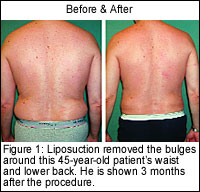
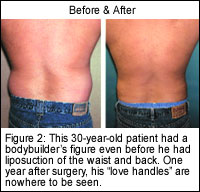
Abdomen. One may think that liposuction is a good way to extract fat from a male patient’s abdomen. In truth, this can be one of the trickiest areas for performing liposuction on a man. Men may have some fat above the rectus muscle, but they may also have internal fat, found inside the intestine, that obviously cannot be suctioned. Consequently, the abdomen is a much more difficult area to treat. In many cases, only about ½ inch of fat will be removed. In certain patients, this may not be enough to produce satisfactory results.
The Case of the “Fat” Bodybuilder
I see many bodybuilders on whom I perform liposuction in the belt, neck, and breast areas. These patients tend to be “in shape”- not overweight-and yet they still show fat accumulations in these areas.
I remember a case in which the patient was 32 years old. He had been a wrestler and a bodybuilder. He was in great shape, but he suffered from gynecomastia and fat in the waist area. As a result, he was uncomfortable taking off his shirt in public, essentially making his goal of becoming a bodybuilder nothing more than an unfulfilled dream.
I performed liposuction around his belt line and removed the gynecomastia. Surprisingly, there was almost pure fat in the waist area. After the fat was removed, the contour of his waist changed dramatically. Now a professional bodybuilder, the patient exhibits a lean chest and a taut waist along with his six-pack abs and impressive biceps. -MB
Breast. There is true gynecomastia, which is enlarged gland or breast tissue, and there is what is known as “pseudogynecomastia,” which does not involve breast tissue. Gynecomastia is literally “woman’s breasts,” from the Greek gyne and mastos. In men, this refers to the tissue, and many true gynecomastia cases are found in athletes or bodybuilders who take steroids, which produce real female breast tissue. If you were to send this tissue to a pathology lab, you would find that it is exactly the same as female breast ductile tissue.
Overweight men have pure fat in their breasts, and you can literally suction it out. I make an incision about ¼ inch long between the dark and light parts of the areola. Through this incision I suction one breast and am able to suction the contralateral breast through the midline as well. Next, I move to the other breast and do the same thing. I find it more efficient to suction the same areas from two different points. This way, there are only two incision points that heal well and are very inconspicuous.
Many physicians place their incisions in the the axillary fold or, worse, in the middle of the chest, because these incisions are easier to make. I suctioned through the axillary fold before I began using the areola method, which I now find delivers the best intraoperative and postoperative results.
The trick with liposuction in the male breast is that many men have a combination of fat and true gynecomastia. These cases require both liposuction and excision of the breast tissue. Performing only liposuction will remove the fat, but it will leave the gynecomastia breast tissue behind.
Gynecomastia tissue looks and feels different from fat. Whereas fat is soft, gynecomastia tissue is more fibrous. If you grab the areola between two fingers and feel hard tissue, you know that excision will be a necessary adjunct to liposuction. In my experience, about 80% of the male patients who have liposuction performed on their breasts also require excision.
You may use the same incision points, under the areola, to perform liposuction and gynecomastia-tissue removal in the same procedure. Performing liposuction alone without removing gyne comastia breast tissue will generally result in an unhappy patient.
Carrying out these procedures concomitantly should take between 1 and 2 hours. Be very careful to ensure hemostasis; otherwise, your patient may return within a day or two with huge breasts—the result of hematoma.
Neck. While it is true that you often do not remove much fat from the neck area, you can nevertheless effect a vital aesthetic change here. If enough suction is applied, the neck’s contour will improve. You may suction only the portion of the neck that is above the platysma muscle. Going below that line starts to become risky.
When I first removed fat from the neck, I entered from the hairline posterior to the ear. Now, however, after marking the area, I make my incision for the procedure at the midline of the neck, 1¼2 inch posterior to the front of the chin. On men, there is a fold suitable for a small incision here. Through this hole, you may liposuction both the left and right sides of the neck.
When I used the behind-the-ear incision, some patients had a temporary weakness in the facial nerve. Their mouths were a little bit crooked on one side for a few weeks. This was the result of disturbing the facial nerve, which extends behind the ear to under the mandible and up into the corner of the mouth.
Indeed, the mandibular branch of the facial nerve is so sensitive that in some cases, you may harm the nerve by simply getting too close to it. I have been making my incision under the chin for the last 5 years, and I have yet to see this type of injury. That said, a combination of the two approaches may be used if you determine that it is necessary.
In many cases, not much fat will be removed—and yet, surprisingly, you will notice the neck’s contour improving. Remarkably, you will see the neck taking shape before your eyes. If you do not see a change at this stage, your patient may not notice a difference down the road. When you think that sufficient fat has been removed from one side, proceed to the other side of the neck.
A word on skin around the neck: As you would expect, if your patient is relatively young, and he is only a little overweight but shows excess fat in the neck area, the skin is usually elastic and the neck’s contour will improve even more. If, however, you are dealing with a person older than 45, the change in the neck’s contour will not be quite as dramatic.
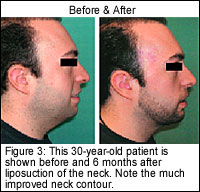 This is illustrated in Figure 3, in which the patient is 30 years old. Removal of small amounts of fat makes a noticeable difference in the neck’s contour.
This is illustrated in Figure 3, in which the patient is 30 years old. Removal of small amounts of fat makes a noticeable difference in the neck’s contour.
Compression. Any time you perform liposuction, it is wise to use compression. Years ago, people wore compression garments for 3 months. That became 6 weeks, and nowadays most people use compression from 3 to 6 weeks. I believe that between 10 and 20 days is sufficient to reduce swelling and bleeding. In the first few hours after surgery, you may put an ice compress on the neck or the chest to alleviate any initial swelling.
Liposuction is an effective option for male patients who suffer from fat in their belt line, chest, and neck. The patient’s abdomen is challenging, because so much of the fat is distributed under the muscle. Also, one must take precautions when performing pseudo gynecomastia liposuction, because, in many cases, some breast tissue will need to be excised. Keeping incision points concealed and to a minimum will also ensure successful outcomes and gratified male patients.
Mordcai Blau, MD, PC, is a board-certified plastic surgeon in private practice in White Plains, NY. He can be reached at (914)-428-4700 or via his Web site, www.gynecomastia-md.com.
Gabriel Sheffer is a contributing writer for Plastic Surgery Products.
Reference
- American Society of Plastic Surgeons. 2005 gender quick facts: Cosmetic plastic surgery. Available at: www.plasticsurgery.org/public_education/loader.cfm?url=/commonspot/security/getfile.cfm&PageID=17865 Accessed June 2, 2006.


